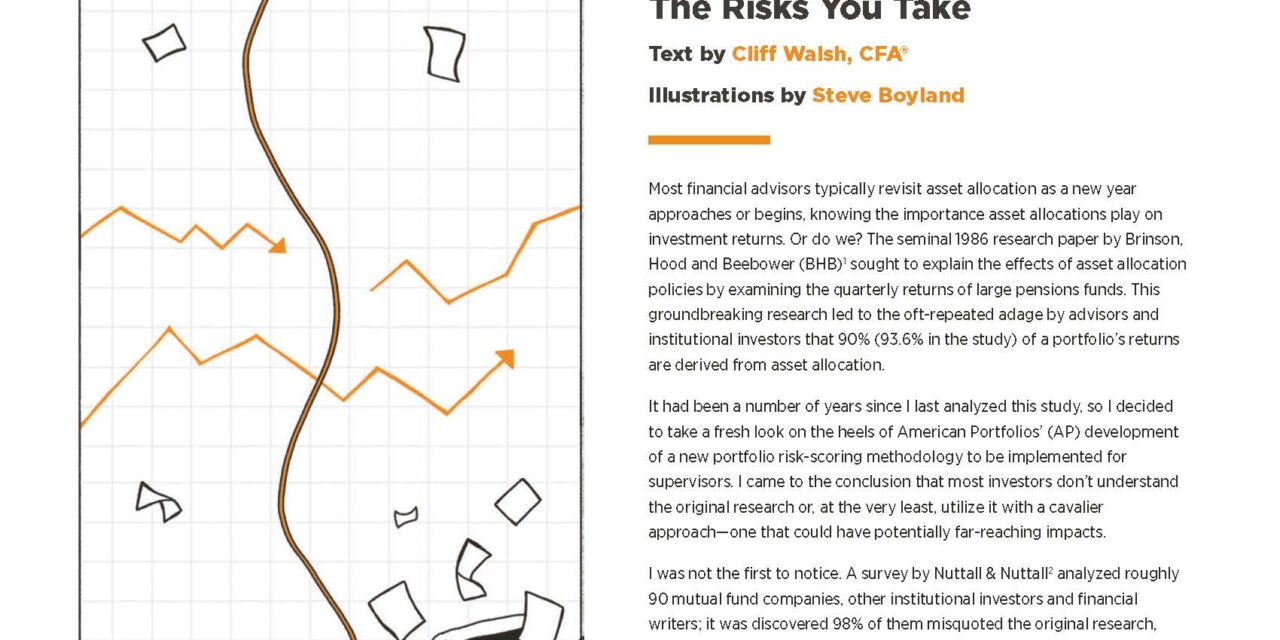
The Risks You Take
Most financial advisors typically revisit asset allocation as a new year approaches or begins, knowing the importance asset allocations play on investment returns. Or do we?
To view the full article please register below:
The Risks You Take
Most financial advisors typically revisit asset allocation as a new year approaches or begins, knowing the importance asset allocations play on investment returns. Or do we? The seminal 1986 research paper by Brinson, Hood and Beebower (BHB) 1 sought to explain the effects of asset allocation policies by examining the quarterly returns of large pensions funds. This groundbreaking research led to the oft-repeated adage by advisors and institutional investors that 90% (93.6% in the study) of a portfolio’s returns are derived from asset allocation.
It had been a number of years since I last analyzed this study, so I decided to take a fresh look on the heels of American Portfolios’ (AP) development of a new portfolio risk-scoring methodology to be implemented for supervisors. I came to the conclusion that most investors don’t understand the original research or, at the very least, utilize it with a cavalier approach—one that could have potentially far-reaching impacts.
I was not the first to notice. A survey by Nuttall & Nuttall 2 analyzed roughly 90 mutual fund companies, other institutional investors and financial writers; it was discovered 98% of them misquoted the original research, which states asset allocation is the primary determinant of a portfolio’s return variability. The research also stated that asset-class timing and active management played minor roles in return variability. So, herein lies the problem. Return variability does not equate to investment return levels or relative performance, but that is exactly the understanding—or misunderstanding—the industry has adopted. Furthermore, returns studied were those from extremely diversified pension funds, which is not necessarily how many invest.
If you take a long-term view, investing in widely diversified, passive indices with little rebalancing, your returns and variability will likely line up with the BHB research. However, the problem becomes more apparent when one takes an active approach to fund, ETF and stock selection, along with frequent rebalancing. Yale Professor Emeritus in Practice of Finance Roger
Ibbotson followed the BHB research with some of his own, entitled “The True Impact of Asset Allocation on Returns,” 3 which found that only 40% of returns between mutual funds were due to asset allocation.
In discussion with dozens upon dozens of investment advisors over the years, it has become apparent many take concentrated stock, industry and sub-asset class positions that deviate from the methodologies utilized by the pension funds studied within the BHB research, while still expecting to be protected by it (i.e., capture 90 – 95% of equity market returns). In Meir Statman’s paper, “How Many Stocks in a Diversified Portfolio?” 4, it was argued that no less than 30-40 stocks were necessary for proper diversification of a portfolio, and that is with a well-thought out approach to diversification as selection occurred, unlike how many approach equity investing today. Add to this the bets made on micro or small-cap stocks, growth versus value concentrations (or vice versa), U.S. versus international leanings, and potential for return deviations from diversified indices compound.
The purpose of bringing this to light is not to endorse passive strategies, but to help advisors understand the risks they are taking and how impactful they can be. Let’s be clear … getting the equity versus fixed income decision correct is extremely important, especially when one’s investment policy statement offers a wide range of investment latitude.
However, as many have realized in recent years, individual investment themes, subsectors and styles can deviate wildly from each other. Even the returns among third-party managers on the AP Advisory Platform highlight this.
One only has to look at the 2019-2020 outperformance of growth over value, which totaled 50%, or even the 11% outperformance of the S&P 500 over the MSCI ACWI index from 2018-2020 to understand the implications of inter-asset class decisions. 5
As you think about asset allocation throughout 2022, I urge you to take a deep dive of your investment decisions over the past few years to see how closely your performance aligns with my assertions. As you look forward, assess each current holding to understand just how wide the range of outcomes could be, noting that behavioral investing research suggests we often underestimate the potential for negative outcomes. We often do this within the Nine Points Investment Management (NPIM) portfolios and add up potential deviations to understand just how much risk we are taking. Our efforts in developing a portfolio risk-scoring methodology should further enhance our ability to understand potential portfolio outcomes. Firm supervisors will utilize these tools—as will our practice management team, in partnership with the NPIM team—to help advisors understand these risks and better align portfolios to clients’ needs, goals and expected
outcomes.
SOURCES:
1. Brinson, Hood & Beebower (July-August 1986). Determinants of Portfolio Performance. Financial Analysts Journal.
2. Nutall, Jennifer & Nuttall, John (1998). Asset Allocation Claims: Truth or Fiction? Unpublished.
3. Ibbotson, Roger & Kaplan, Paul (January-February 2000). The True Impact of Asset Allocation Returns. Financial Analysts Journal,
4. Statman, Meir (September 1987). How Many Stocks Make a Diversified Portfolio? Journal of Financial and Quantitative Analysis
5. FactSet Research












